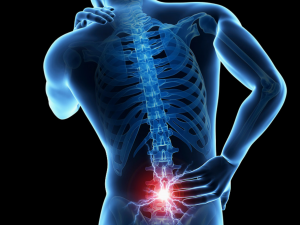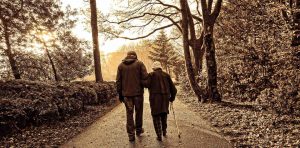Spinal Stenosis
The narrowing of bony canals in which the spinal cord and its innervations travel through can disrupt nerve conduction and cause an array of issues throughout the body. Physicians refer to this narrowing as spinal stenosis. Spinal stenosis refers to the narrowing of the main spinal canal that runs through the spine and protests the spinal cord. At every level of the spine nerve roots innervate outward into the body through structures called foraminal canals. Narrowing of the foraminal canals has a slight nomenclature difference and carries the name foraminal stenosis. Either way the pressure exerted on the nervous system may cause pain, numbness, and weakness.
Congenital vs. Degenerative Spinal Stenosis
Stenosis originates from two potential causes. A small number of people are born with back problems that develop into spinal stenosis. People with this condition refer to it as congenital spinal stenosis. Congenital spinal stenosis occurs most often in men and usually presents when they are in their thirties to fifties when normal degenerative changes add in addition to their natural physiological conditions that put them at higher risk.
Stenosis most often results from the normal aging process. As people age, the soft tissues and bones in the spine may harden and overgrow. 95% of the population have diagnostically visible degenerative changes to the spine by the age of 50. Spinal stenosis usually starts to occur in patients over the age of 60 when the degenerative changes start to cause noticeable issues. Subjecting bones to damage and pressure they respond by thickening the bone and can form bone spurs. Thickening in a spinal canal or bone spurs in a spinal canal narrow the space around the spinal cord and result in spinal stenosis.
While congenital stenosis manifest more often in men, distributions of degenerative stenosis do not seem to corelate with gender. However, correlation does exist for women in higher rates of incidence for spinal stenosis presenting with symptoms that require treatment.
Causes of Spinal Stenosis
The prevailing cause of degenerative nature for spinal stenosis falls under arthritic changes. All non-sesamoid bones in the body that form any joint have cartilage cushioning to protect and lubricate the bones health during movement. Arthritis refers to the physiological changes that occur when cartilage breaks down and pressure starts to damage the bone inside of a joint. In the spine, arthritis can result as the disc between vertebrae degenerates and looses hydration. Hydration levels inside of the vertebral discs tend to peak in children and young adults, but as we age our discs weaken and start to dry out. This loss of hydration reduces the volume of the jelly inside of the discs, lowering the ability for the disc to maintain the size of gap between vertebral bones. This loss of disc height called settling, or collapse, transfers unsupported weight to the facet joints behind the spinal cord. Pressure on facet joints between two levels of vertebra reduces the size of the foraminal canals where nerves innervate off the spinal cord causing potential compression.
As the facet joints experience increased pressure the cartilage starts to deteriorate and develop arthritic damage similar to the hip or knee joints. The cartilage that covers and protects the joints wears away. When the cartilage wears away completely the bones contact points in the joint rub against each other. Bone on bone rubbing may trigger bony growth to fuse and stabilize the failed joint and support the vertebrae. Over time this bony overgrowth, called bone spurs, may narrow the space inside of the foraminal canal even further. The final additive stress put on the canals from degenerative changes includes the ligaments holding the bones in place start to thicken as the weight load shifts increasing stress on them. This thickening of the ligaments intrudes into the space in which nerves pass potentially inflicting painful nerve irritation from the compression.
Symptoms of Spinal Stenosis in the lumbar region
Back Pain from Spinal Stenosis
 Back pain from spinal stenosis does not always occur and when it does it manifests from the degree of arthritis that developed and contributed to the spinal stenosis. Spinal nerves relay sensation to specific regions of your body, and pain in those regions can occur due to compression of the associated nerves when arthritic changes apply pressure. When compression affects nerves that relay signals to the back specifically then patient will feel back pain. Otherwise typically stenosis pain in the lumbar region manifests with sciatica, the radiating pain traveling down the buttock towards the feet, and stenosis pain in the cervical spine manifests by radiating pain down into the arms.
Back pain from spinal stenosis does not always occur and when it does it manifests from the degree of arthritis that developed and contributed to the spinal stenosis. Spinal nerves relay sensation to specific regions of your body, and pain in those regions can occur due to compression of the associated nerves when arthritic changes apply pressure. When compression affects nerves that relay signals to the back specifically then patient will feel back pain. Otherwise typically stenosis pain in the lumbar region manifests with sciatica, the radiating pain traveling down the buttock towards the feet, and stenosis pain in the cervical spine manifests by radiating pain down into the arms.
Sciatica: Burning pain in the buttocks or legs
Pressure on spinal nerves can result in pain for the areas that the nerves supply signal to. The pain manifests in variable intensity as an ache or a burning feeling. Sciatica get its name from the sciatic nerve which travels down through the pelvis and into the legs. Pain that radiates down the leg typically falls under the name sciatica and originates from the lumbar region of the spine. Sciatica pain often starts in the buttock and radiates down one leg and may stop at the calf or all the way into the feet.
Numbness or tingling in the buttocks or the legs
As pressure on the nerve increases, numbness and tingling often accompany the burning pain. Not all patients experience both and may only experience the burning sensation, or only experience the tingling sensation.
Weakness in the legs or “foot drop”
One of the final stages of symptoms that manifests from nerve compression that associates with stenosis includes the weakening of the muscles downstream of the compression. Weakness in one or both legs warrants letting your spine surgeon know that day. At this point lasting damage to the nerve can occur and will occur if given enough time. Severe cases of weakness can progress to a symptom called “foot drop.” The term foot drop describes the loss of control of the front portion of the foot, causing it to drag or slap the ground when walking.
Less pain with leaning forward or sitting
 Bending the spine forward or sitting shifts the pressure of your spine into a position that increases the amount of space in the spinal canals offering temporary relief from the pain associated with lumbar spine stenosis. Pain may then worsen when standing up for prolonged periods of time or walking. Some patients note that they can comfortably ride a stationary bike or walk if they lean on a shopping cart but walking more than a block or two unassisted brings on severe sciatica or leg weakness.
Bending the spine forward or sitting shifts the pressure of your spine into a position that increases the amount of space in the spinal canals offering temporary relief from the pain associated with lumbar spine stenosis. Pain may then worsen when standing up for prolonged periods of time or walking. Some patients note that they can comfortably ride a stationary bike or walk if they lean on a shopping cart but walking more than a block or two unassisted brings on severe sciatica or leg weakness.

